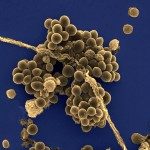Link to Pubmed [PMID] – 16123424
Invest. Ophthalmol. Vis. Sci. 2005 Sep;46(9):3233-8
PURPOSE: Bacillus endophthalmitis is a highly explosive infection of the eye that commonly results in rapid inflammation and vision loss, if not loss of the eye itself, within a few days. Quorum-sensing-controlled toxins are essential to virulence during infection. Another unique characteristic of this disease is the ability of Bacillus to replicate rapidly and migrate to all parts of the eye. This study was conducted to determine the combined roles of toxins and motility during Bacillus endophthalmitis.
METHODS: Rabbit eyes were injected intravitreally with approximately 100 cfu of wild type, nonmotile, or nonmotile/quorum-sensing-deficient Bacillus thuringiensis. Infection courses were analyzed by biomicroscopy, histology, electroretinography, and quantitation of bacteria and inflammatory cells.
RESULTS: Infection with wild type B. thuringiensis resulted in complete retinal function loss by 18 hours after infection, whereas nonmotile B. thuringiensis infections required 30 hours to achieve a reduction of >90% in retinal function. Further attenuation of infection resulted from infection with the nonmotile/quorum-sensing-deficient B. thuringiensis strain, with approximately 90% retinal function loss occurring at 36 hours. Overall, the nonmotile and nonmotile/quorum-sensing-deficient mutants were significantly less virulent than wild-type B. thuringiensis.
CONCLUSIONS: The results demonstrate that, in addition to quorum-sensing-controlled toxin production, bacterial migration within the eye contributed to the rapidly fulminant and destructive course of Bacillus endophthalmitis. Motility and quorum-sensing may therefore represent possible targets for the development of therapies designed to attenuate the devastating effects of Bacillus in the eye during endophthalmitis.

